Ready to start your own organic vegetable garden today? First things first, find a sunny spot that gets at least six hours of light—think of it as your plants’ sunbathing paradise! Choose fun seeds like purple carrots or striped tomatoes for a splash of color. Prepare your soil like a chef mixing the perfect recipe: add compost for nutrients. With a little love, some water, and natural pest control, you’ll soon harvest fresh, delicious veggies! Stick around to discover more tips!
Choosing the Right Location for Your Garden
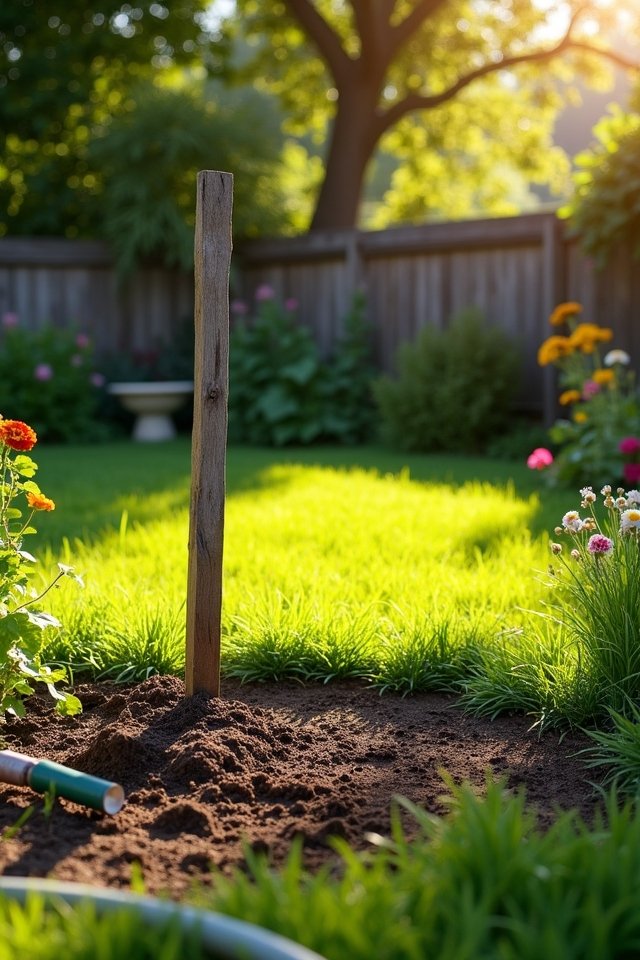
Have you ever wondered where the perfect spot for your organic vegetable garden might be? Picture a sun-kissed corner in your yard, where sunlight exposure wraps around your plants like a warm blanket. Finding a spot that gets at least six hours of sunlight daily is essential. Not only does it help your veggies thrive, but it also means fewer pests—bonus!
Garden accessibility matters, too! Choose a location that’s easy for you to reach, so you can munch on fresh tomatoes without breaking a sweat. Maybe a raised bed near your kitchen door? Imagine plucking herbs while whipping up dinner! Remember, your garden should be a joyful retreat, not a backyard obstacle course. Plant a little magic where it’s most convenient!
Selecting Organic Seeds and Plants
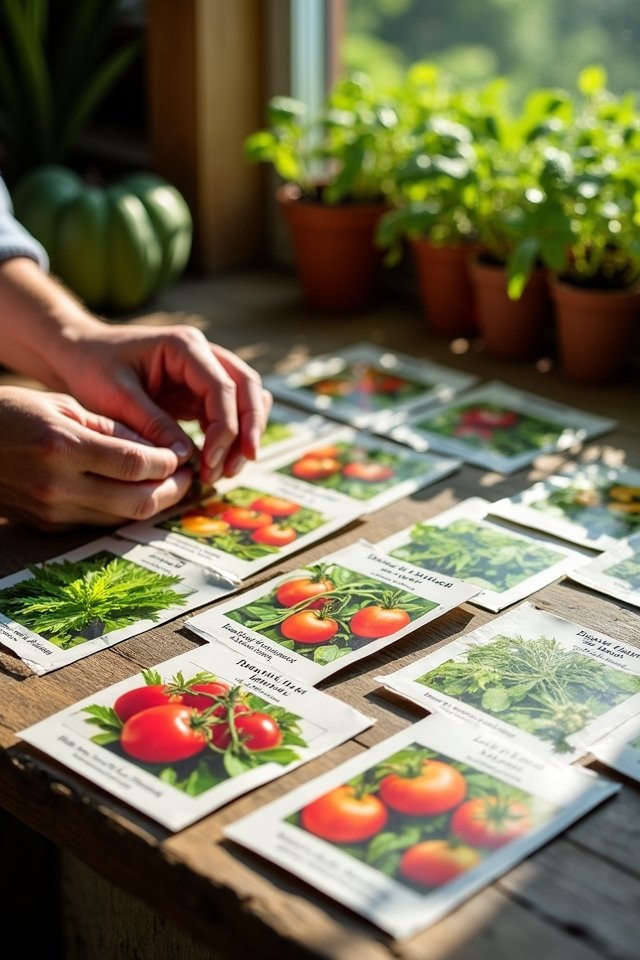
With your garden location all picked out, it’s time to think about what you’re actually going to plant! Why not plunge into those vibrant seed catalogs? You’ll find a treasure trove of organic seeds, including delightful heirloom varieties that burst with flavor and history. Imagine plucking sun-ripened tomatoes, whose rich reds can make your mouth water! Plus, growing stunning heritage plants connects you to the past. Looking for a unique twist? Try purple carrots or striped tomatoes! They’re not just pretty; they’ve got flavor that’ll dazzle your taste buds. So, spread your creative wings, mix and match colors and tastes, and watch your garden bloom into a culinary masterpiece! Isn’t that what gardening is all about? Happy planting!
Preparing Your Soil for Planting
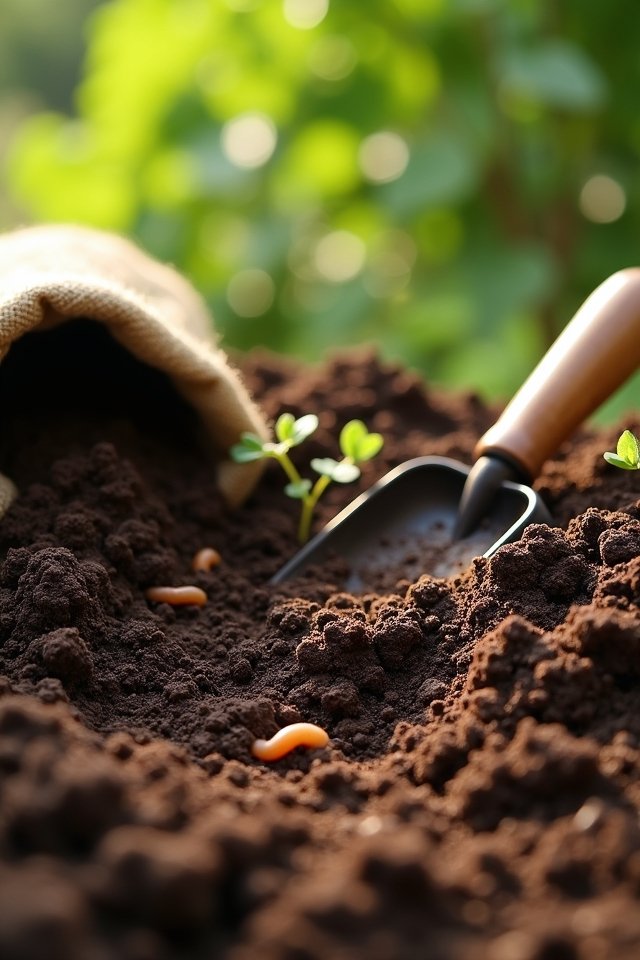
Getting your soil ready for planting is like preparing a cozy bed for your seeds to snuggle into. Start by testing your soil’s pH—who knew your dirt could have feelings, right? Most veggies love a pH between 6.0 and 7.0. If it’s too acidic or alkaline, think of soil amendments as your garden’s mood boosters! Add organic compost or well-rotted manure to enhance nutrients and improve texture. It’s like giving your soil a luxurious spa day! Incorporate these amendments thoroughly, turning them into the soil until they blend beautifully. Don’t rush! Your plants deserve the best start. With a little love and attention, you’ll have a rich, welcoming environment for your vegetables to thrive, making every bite worth it!
Natural Pest Control Methods

While pests might seem like a relentless army invading your cozy vegetable haven, don’t worry! You’ve got some exciting, innovative strategies up your sleeve. First, let’s talk about beneficial insects—those little heroes like ladybugs and lacewings that love snacking on nasty pests. By inviting them into your garden, you create a natural balance. Companion planting is another genius move! Pairing tomatoes with basil or marigolds can deter unwanted critters while enhancing growth. Imagine fragrant herbs and vibrant flowers working together like a well-oiled team! To kick pests to the curb, sprinkle diatomaceous earth around your crops or brew a garlic spray. It’s like giving your plants a superhero cape against pests! Your vegetable garden’s vibrant future is within reach!
Watering Techniques for Healthy Vegetables
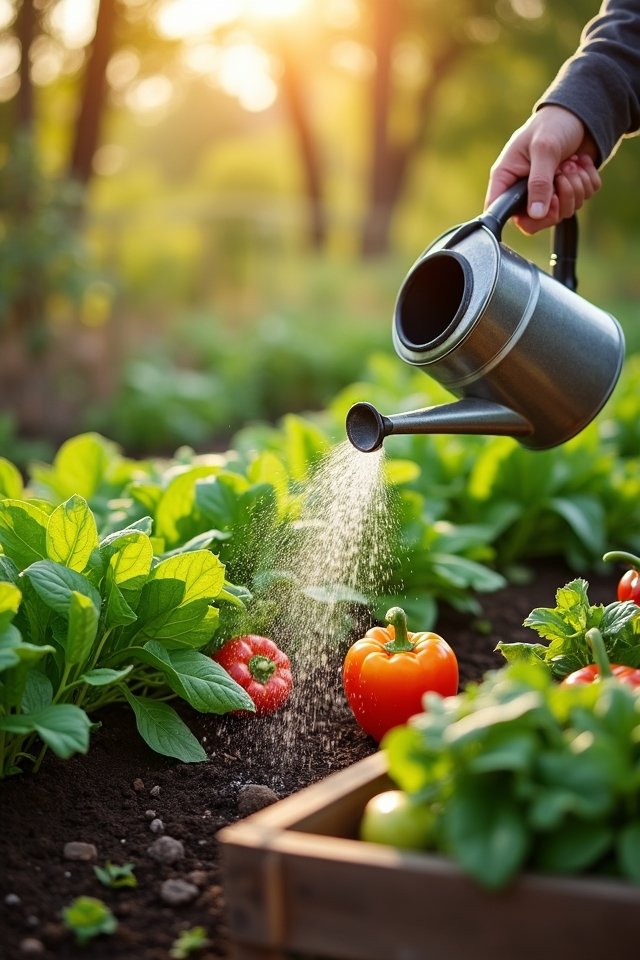
After you’ve set up your garden defenses against pesky intruders, it’s time to guarantee your leafy friends get the hydration they crave! Think of drip irrigation as a tiny spa day for your vegetables, delivering water directly to their roots while minimizing waste. Isn’t that brilliant? Plus, it enhances moisture retention, so your plants can sip rather than drown, especially during those hot summer days. Try a simple setup with soaker hoses or a DIY drip system; it’s like giving your veggies a rejuvenating drink without all the fuss! And remember, watering in the early morning lets the sun work its magic, rather than letting moisture evaporate. Your garden awaits—let’s make it flourish with smart, innovative hydration techniques!
Maintaining Your Organic Garden Throughout the Season
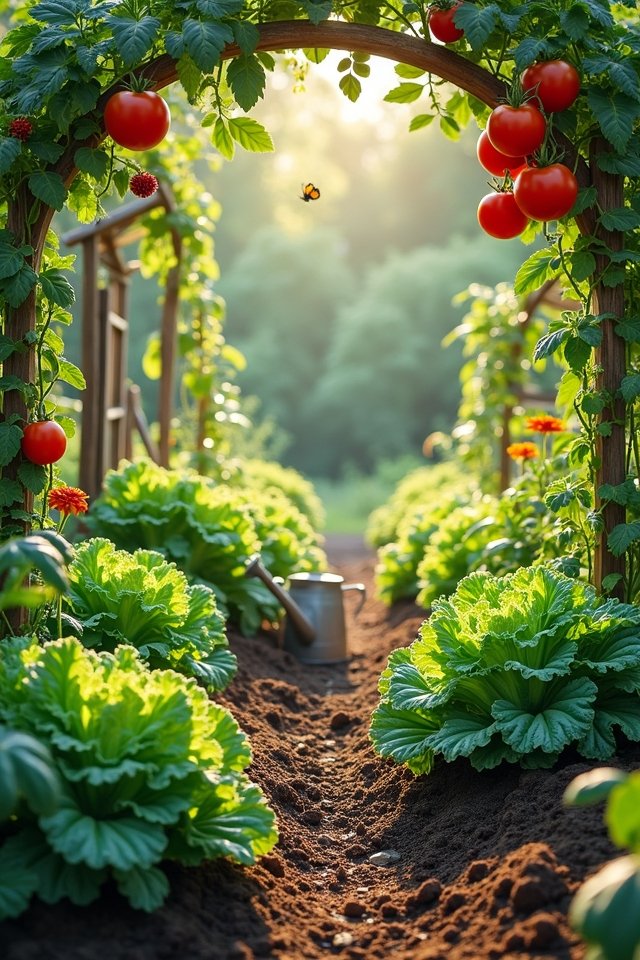
To keep your thriving organic garden in tip-top shape throughout the season, you’ll want to adopt a little routine that feels more like play than work! Think of crop rotation as a tasty game; by swapping your veggies, you’re not only preventing pests but also keeping the soil rich and happy! Ah, the joy of healthy plants! Don’t forget about seasonal pruning—it’s like giving your plants a stylish haircut! Trim away the dead leaves and let the sun kiss the new growth! You’ll see your garden sparkle with vibrant energy! Plus, speaking of energy, don’t underestimate the power of your compost pile—it’s a secret weapon full of nutrients! Ready to dig in? Your garden adventure awaits!
Frequently Asked Questions
What Organic Fertilizers Are Best for Vegetable Gardens?
When it comes to nourishing your vegetable garden, think of organic fertilizers as a delicious feast! Compost tea is like a nutrient-rich smoothie, giving your plants a bubbly boost. On the other hand, fish emulsion’s a savory treat packed with essential minerals, ensuring lush growth. Why not mix them for a powerful potion? Just picture your vibrant veggies dancing with delight! You’ll have a garden that’s as happy as a clam. Isn’t that a goal worth chasing?
How Much Sunlight Do Vegetables Need Daily?
When it comes to vegetable growth, sunlight requirements can’t be overstated! Most veggies absolutely crave 6 to 8 hours of sunlight daily. Picture your tomatoes basking like sunbathers on a beach! If they skimp on this golden goodness, you’ll end up with sad, leggy plants. Even shade-loving greens need some warm rays to thrive! So, find that glorious spot in your yard and watch your garden flourish! Isn’t that exciting?
Can I Garden if I Have Limited Space?
Absolutely, you can garden even with limited space! Think container gardening—it’s like giving your plants a cozy apartment. Try colorful pots filled with herbs or tiny tomatoes! You can also explore vertical gardening, hanging your greens like art. Picture lush vines climbing a trellis, making your space feel like a vibrant forest! So, roll up your sleeves and don’t let space hold you back! Happy gardening! Isn’t nature just fantastic?
What Common Diseases Affect Organic Vegetables?
Did you know that around 40% of organic vegetables can fall prey to diseases? It’s a staggering statistic! To keep your garden healthy, focus on disease prevention and pest management strategies. Rotate your crops like a fun dancing partner to stop disease buildup! Regularly inspect your plants for any sick leaves or little pests that might be lurking. Save your veggies from unwanted guests; they’d rather stay delicious and vibrant, wouldn’t they?
When Is the Best Time to Harvest My Crops?
When’s the best time to harvest your crops? Well, watch for those harvest indicators! Carrots need smooth skins, while tomatoes should sport vibrant colors. Seasonal timing’s essential—spring veggies are ripe by early summer, while fall veggies often wait ‘til the first frost. Imagine sinking your teeth into a sun-warmed tomato, bursting with flavor! Isn’t that a delightful thought? So, pay attention, and you’ll enjoy the delicious rewards of your hard work!


